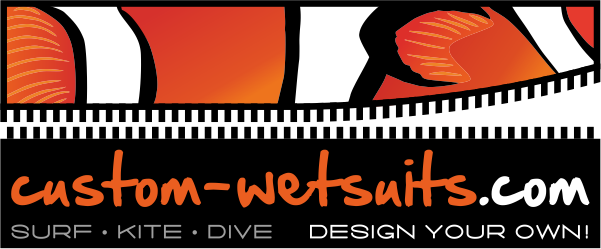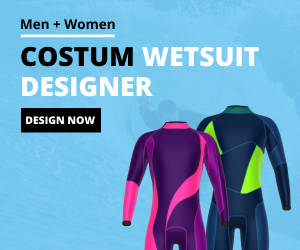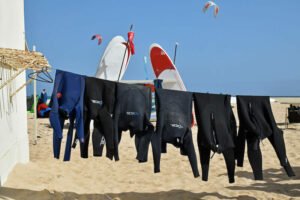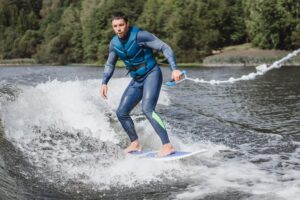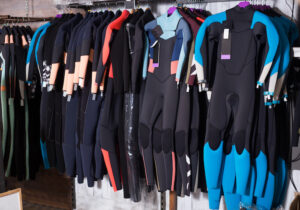Embarking on a thrilling journey into the world of surfing? Picking the right surfboard can make all the difference in mastering those waves and experiencing the adrenalin rush of riding them. As a beginner, the surfboard you pick sets the foundation for your progress and enjoyment. In this article, you will learn what is the best surfboard for beginners.
We’ve gathered a carefully curated list of the most important key aspects you need to consider when picking your first surfboard. Simply work through them one by one and find the perfect board to kick-start your surfing adventure with confidence and excitement!
In this article, you will get answers to the following questions:
- Which material is best for a beginner’s surfboard?
- What surfboard shape is best for starting to surf?
- How to pick the perfect surfboard size?
- Are longboards or shortboards better for surf beginners?
5 Key Aspects – How to Find the Best Surfboard for Beginners
Whether you’re a newbie catching your first wave or seeking an upgrade, choosing the right surfboard can make the difference between standing the first try or quitting after a day full of frustration.
Many before you, not even excluding absolute pro surfers, have made the mistake of picking a surfboard carelessly or orienting their choice on the wrong factors. You don’t learn driving in a Ferrari. Just because Kelly Slater surfs on one specific board, it doesn’t make this surfboard a good choice for everyone.
In the following, we will direct you step by step down the road, leading to your personalized dream board.
Here are the most important facts to consider when making your choice:
- Board size
- Deck material
- Fins
- Skill level
- Surf location
Looks easy? Exactly! Get your notepad and pencil ready and off we go checking off our list… Let’s find out what is the best surfboard for beginners.
Step 1: Length, Width and Thickness of your Board
The universe of surfboard shapes is almost as diverse as our sun system. From big lightweight Longboard-Jupiter to small and fast Shortboard-Mercury or Funboard-Earth as the perfect compromise between the two extremes.
For the sake of focusing on the goal of finding you the best beginners surfboard, we will ignore the more advanced board types from now on and concentrate on those, giving you the best conditions possible.
Whilst shortboards, fish surfboards, and asymmetrical surfboards require a certain skill level, longboards as well as funboards come big enough to offer a good amount of buoyancy to leave you stable enough to focus on standing up.
A funboard, also known as a Malibu surfboard, combines the flotation of a longboard with the maneuverability of shortboard. This hybrid surfboard is shorter than traditional longboards but longer than shortboards and is designed for having fun in the water.
Length
Funboards are usually 6’5”-8’5” feet tall and depending on the rider’s height and weight will be chosen inside this range. As a rule of thumb, you want your funboard to be at least one foot taller than you.
Yet, the safer and maybe even faster start into your surfing career might come to you in the shape of a longboard. If you have never stood on a surfboard ever in your life, a longer board can give you the perfect and stable entrance into the wobbly world of waves.
Longboard Size Chart
Surfer’s weight Beginner Intermediate
<55 kg 6’8’’ – 7’2’’ 6’8’’ – 7’0’’
55 – 65 kg 7’2’’ – 7’6’’ 6’10’’ – 7’2’’
65 – 75 kg 8’0’’ – 8’6’’ 7’0’’ – 7’6’’
75 – 85 kg 8’6’’ – 9’2’’ 7’6’’ – 8’0’’
85 – 95 kg 9’2’’ – 9’6’’ 8’0’’ – 8’6’’
>95 kg >9’6’’ 8’6’’ – 9’2’’
Longboards are great, but once you feel comfortable on them, learning how to ride down the face of a wave and perform basic turns can be challenging. Where their large size was once helpful, it may now hold you back.
The decision is yours to make. Slow and steady or the possibility of a bumpy start with the option of leveling up on the same surfboard?
This decision makes it advisable to rent a surfboard instead of buying one, especially at the beginning of your surf journey. Then you can effortlessly adjust your surfboard size to your continuously growing skill set.
Width
A surfboard’s width might not sound that essential. But all the ones of you who ever tried a very slim surfboard, will probably agree that it actually does matter. A broader board provides more stability, especially for those still developing their balance and paddling skills. Opt for a surfboard with a wider outline.
A good width for beginner surfboards ranges between 22’’ – 24″ from the widest point of one surfboard rail to the other. In between a funboard and a longboard doesn’t exist an enormous difference when it comes to the width. Most beginner’s funboards come with a width of 22’’.
Thickness and Volume
The thickness and volume of your surfboard correlate directly with its buoyancy. In the same way, the surfboard’s volume has to be adapted to the weight of its rider. The further a surfboard is pushed down into the water, the more tricky the paddling and standing up can be.
A thicker board will keep you on the water’s surface and help prevent nose diving. Volume is the measurement, in liters, of essentially how much space your surfboard takes up, specifically the amount of water it displaces.
You will want to look for a surfboard with a thickness somewhere between 2.5’’-3’’ and a volume that is 2 to 3 times your body weight (in kilograms).
Remember that finding the perfect surfboard size may involve some trial and error. Don’t be afraid to test different boards and seek advice from experienced surfers or knowledgeable staff at surf shops. With the right surfboard size, you’ll have a solid foundation to start your surfing journey with confidence.
Step 2: Hard Top vs. Soft Top
- Material
- Soft Top: Soft-top surfboards have a foam deck that provides a cushioned and forgiving surface. The foam deck makes them more buoyant and safer, especially for beginners and those learning to surf.
- Hard Top: Hard-top surfboards are constructed with a rigid outer shell, typically made of fiberglass, epoxy, or other composite materials. They offer better performance and responsiveness compared to soft tops, but are less forgiving on falls and wipe outs.
- Durability
- Soft Top: Soft-top surfboards are generally more durable and able to withstand dings and impacts better than hard-top boards. This durability is beneficial for beginners and those learning to surf, as they might be more prone to causing damage to the board.
- Hard Top: Hard-top surfboards can be more prone to dings and damage compared to soft tops. They require careful handling and maintenance, especially in crowded lineups where collisions with other surfers may occur.
- Performance
- Soft Top: Soft-top surfboards are great for beginners and recreational surfers who prioritize safety and stability over high-performance maneuvers. They are ideal for learning and building confidence on the waves.
- Hard Top: Hard-top surfboards are designed for more experienced surfers who seek high-performance capabilities. They allow for better control, maneuverability, and responsiveness, making them suitable for more advanced surfing techniques.
- Price:
- Soft Top: Soft-top surfboards are generally more affordable than hard-top boards. They are a cost-effective option for beginners and those on a budget.
- Hard Top: Hard-top surfboards are usually more expensive due to their higher performance and construction materials. They are an investment for intermediate to advanced surfers who want to improve their skills and style.
- Suitable Conditions
- Soft Top: Soft-top boards are versatile and work well in a wide range of wave conditions. They are excellent for learning in small to medium-sized waves.
- Hard Top: Hard-top boards excel in more powerful and larger waves, where precise control and responsiveness are essential for executing advanced maneuvers.
Indeed, when considering both internal and external factors, the result appears to be clear and unambiguous. Hard top surfboards have a clear advantage when used by an experienced rider under more challenging conditions. But the best surfboard for beginners clearly seems to be a soft foam board.
It is also important to take care of your board and wax your surfboard. Read here why you have to wax your surfboard.
Step 3: Fins
Stability. Control. Ease of use. The holy trinity of the best surfboard for beginners. The question we need to ask now for step 3 is, which fin set-up can give me exactly that?
The fins on the bottom of the surfboard are not only responsible for directional control, but also affect stability, maneuverability, and overall control significantly. These two main set-ups can provide you with exactly that:
- Single Fin (2+1 Setup) – A single large center fin with smaller side fins. This setup offers stability and control, making it suitable for beginners learning to ride straight and catch small waves.
- Thruster (3-Fin Setup) – Three fins arranged in a triangular pattern. This setup provides a balance of stability and maneuverability, making it versatile for beginners who want to progress in their surfing skills.
Some surfboards for beginners come with softer rubber fins. These fins are forgiving, enhance safety, and provide stability, making them ideal for your first ever surfing steps.
If that doesn’t match your skill level, and you are looking for a set-up to step up the game, you can give the Quad fins a try. Four fins, two on each side, designed to offer speed and responsiveness. Quad setups can provide a good balance of stability and maneuverability for beginners looking to improve their turning skills.
Step 4: Level of Skill
You will never forget your first surf experience. Let’s try to make it a good one. It is crucial to assess your surf skill level honestly for several important reasons.
Starting with your safety and the safety of your fellow surfers. If you can’t control a board, the waves will control you! And a board to the head was pretty surely never the start of a great surf experience!
Assess your surfing skill level honestly. If you’re an absolute beginner, you’ll want a board with features that enhance stability and buoyancy. If you have some experience, you might consider a board that allows for more maneuverability.
Understanding your strengths and areas for improvement builds confidence, as you can approach challenges with a clear understanding of what you can handle and what you need to work on.
Step 5: Choosing a Surfspot
The type of waves you’ll be surfing most often should also influence your decision about the type of board you want. If you’re learning in small, mellow waves, you may want a different board than if you’re tackling bigger, more powerful waves.
Especially when you are just getting into surfing, it is recommended to learn the basics with a professional surf instructor. They can teach you not only the proper surf skills but also guide you to the best surf spots suitable for beginners and provide valuable information about the currents at the beach you’ve chosen.
Your first attempts will most likely be on a significantly bigger soft top board, they are the best foam surfboard for beginners. But because of the volume, they make it harder paddling out across stronger waves.
Whitewash as you find it along most sand shores is where most surf schools start their lessons. And the big advantage: No long paddling-out-distances!
The big foam board will give you the best balance here, so you can focus on standing up for the first time and learn how to make the first little steering attempts.
If you have done that and want to move on, you can size down on the board. Getting out to your first green waves with a foam surfboard can be frustrating. You paddle forward, but the waves push you back every time.
The smaller the board, the easier you can maneuver your board out to the point break as well as on the wave back to the shore.
Thumb rule:
The smaller the waves – the bigger the board. The more power the wave has – the narrower the board.
Dos and Don’ts
So it’s time to decide now. Making a decision about your first surfboard can be overwhelming with all the information. Here’s a concise summary of the most common mistakes to avoid and helpful tips to guide you:
- Do Prioritize Stability Over Performance: Focus on stability and ease of use rather than advanced features or performance characteristics that may not be necessary for beginners.
- Do Rent or Borrow Before Buying: Test different types of boards through rentals or borrow from friends to get a feel for what suits you best before making a purchase.
- Do Seek Professional Advice: Consult experienced surfers or professionals at surf shops to help you find a suitable board based on your skill level, size, and local wave conditions.
- Don’t Rush to Advanced Boards: Avoid transitioning to a more advanced board too quickly; ensure you have a solid foundation of basic skills first.
- Don’t Underestimate the Learning Curve: Learning to surf takes time and practice. Be patient and don’t expect immediate mastery.
- Don’t Get Overwhelmed by Aesthetics: While aesthetics are important, focus on the board’s functionality and suitability for your skill level.
Remember, there is absolutely no embarrassment in being a beginner. Take your time, select a skill appropriate surfboard and the surfer community will be celebrating every little step you take, becoming better and better.
Conclusion: What is the best surfboard for beginners?
Choosing your perfect wave companion is never an easy choice. In fact, it is a pivotal decision that can shape your entire surfing experience. Through the waves of information and advice, we’ve navigated the seas of options, highlighting the essential factors and considerations.
From understanding the nuances of board size and shape to grasping the significance of stability and buoyancy, you’ve gained insight into the art of selecting your perfect beginner’s surfboard. By embracing honesty, patience, and the willingness to learn, the best foundation for your surfing journey has already been set.
Rest your decision on the foundation of safety, stability, and trust in the learning curve, and the best surfboard for beginners should be whatever surfboard you decided on.
FAQ – Most asked questions about the best surfboard for beginners
Depending on your own height and weight, you will want to adjust the surfboard’s length and volume. Funboards range from 6’5”-8’5” while longboards can be even longer up to 9’’. The longer the surfboard, the easier it should be to keep balance.
If you are just starting out and want to take your first surfboard ever into the waves, choosing a soft top surfboard is commonly highly recommended. Foam surfboards offer more buoyancy and can make paddling as well as standing up much easier.
Expensive does not equal better! Many surfboards that pro athletes use are not suited for surf newbies. Also, if you want to level up, you most likely will want to switch to a different board. So maybe better start by renting a good surfboard for beginners and invest later in your surfing career in a longer lasting surf companion.
The best surfboard for beginners should prioritize buoyancy, stability, and safety. By picking a surfboard with more length and volume, forgiving fins and a soft top, those demands should be met. Yet, everybody can adjust their choice according to their personal preferences, body, and skill set.
